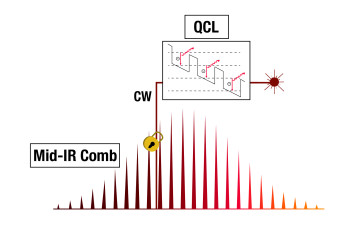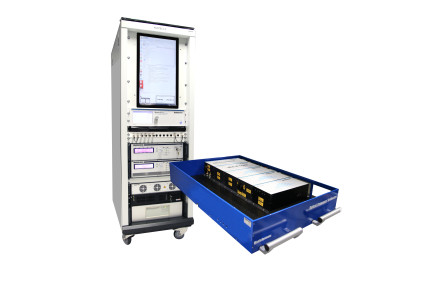Menlo Systems' product:
Stabilized in the infrared

Researchers at the Laboratoire de Physique de l’École Normale Supérieure in Paris have optimized a quantum cascade laser with the help of a frequency comb from Menlo Systems. The work is an important building block for the future use of quantum cascade lasers as frequency combs in the mid-infrared.
They are still somewhat exotic among laser systems: quantum cascade lasers (QCL). This is because not many laser media are able to emit coherent light between three and 20 micrometers (µm). Quantum cascade lasers operate precisely in this wavelength range of the mid-infrared. QCLs are a special type of semiconductor laser. Due to their versatile applications and unique properties, they have become increasingly popular in recent years. The problem is that the systems are still not as stable as one would like. Dr. Baptiste Chomet and Dr. Djamal Gacemi and their colleagues from Carlo Sirtori’s group at Laboratoire de Physique de l'École Normale Supérieure de Paris together with Olivier Lopez and Dr. Benoit Darquié from Laboratoire de Physique des Lasers in Paris have now addressed exactly this. They have constructed a QCL that is more stable than conventional systems and have thus taken a significant step towards a fully-stabilized QCL frequency comb system. The researchers used a frequency comb from Menlo Systems as an optical reference.
It was a small revolution in semiconductor technology in the 1990s: the quantum cascade laser. It produced light through quantum mechanical tunneling and cascading of electrons in so-called "quantum wells". Quantum wells are thin semiconductor layers in which electrons are trapped. The QCL consists of a sequence of quantum wells designed to form an electronic periodic potential, with quantum barriers separating the quantum wells from each other. Electrons can tunnel through these barriers when the electronic energy levels are at the same on both sides of the barrier. Using this tunneling process it possible to increase the electron population in the upper state of the laser transition, which leads to the formation of optical gain and eventually laser emission. The wavelength of the emitted light can be precisely controlled by a targeted design of the quantum wells and barriers. Quantum cascade lasers thus offer access to the mid-infrared (mid-IR) spectral range (3 µm – 20 µm). This wavelength range is virtually untapped by other type of laser. QCLs are attractive due to their finely-adjustable narrow-band spectra and continuous-wave powers of up to several watts. The problem with this is that they are susceptible to frequency and phase fluctuations and are therefore not yet extremely stable.
Dr. Baptiste Chomet, Dr. Djamal Gacemi, and their colleagues from Carlo Sirtori’s group at the École Normale Supérieure de Paris, together with Olivier Lopez and Dr. Benoit Darquié from Laboratoire de Physique des Lasers in Paris have now worked on this.
In their publication "Highly coherent phase-lock of an 8.1 µm quantum cascade laser to a turn-key mid-IR frequency comb", Baptiste Chomet and his colleagues demonstrate coherent phase locking of a continuous-wave Fabry-Pérot quantum cascade laser to a low-noise mid-IR optical frequency comb from Menlo Systems (Mid-IR Comb 5-8-14), which covers a spectral window from 7.4 µm to 9.4 µm. This coherence phase locking transferred the stability of the reference comb to the QCL. This was achieved by superimposing light from the QCL and the Menlo frequency comb on a photodetector and measuring the phase difference between the two. Based on this phase difference, a correction signal was applied to the QCL’s driving current in order to make it much more stable, aiming for a level of stability comparable to that of the Menlo frequency comb.
In general, frequency combs are used to measure optical frequencies, i.e. oscillations of light, with extreme precision. This is why frequency combs are also known as ‘laser rulers’ for light. The Nobel Prize-winning technology performs extremely reliably over a wide wavelength range, and ensures unparalleled stability in laser-based high-precision applications.
Through this transfer of stability of the frequency comb to the QCL, the researchers can now use the comb as an ultra-precise reference. They succeeded in reducing the linewidth of the QCL laser by more than two orders of magnitude, reaching the sub-kHz range within an observation time of one millisecond. The narrower the linewidth of the frequency comb, the more precisely the stability can be transferred. This is analogous to a clock: the more oscillations within a unit of time, the more accurate the clock is.
"Our experiment is an important step towards the development of metrologically-suitable QCLs and fully-stabilized QCL frequency combs," explains Djamal Gacemi. "It opens up new perspectives for precision measurements and frequency metrology in the mid-infrared range."
The development of quantum cascade lasers has advanced considerably in the recent years. Optimization of the quantum structure has now made it possible to enhance the efficiency and emission wavelengths of the laser. This has opened the door to many industrial and scientific applications of QCLs: In spectroscopy they help identify and quantify chemical compounds based on their infrared absorption; in free space communication, they can be used as high-speed sources for data bit transmission; in medicine QCLs are used to visualize tissue and for diagnostics; and in the environmental sciences they are used as sensors to measure the concentration of pollutants and gases in the atmosphere.
"These applications are just a small part of what can be achieved with quantum cascade lasers," Djamal Gacemi is convinced. "For instance, locking the Menlo comb itself to a remote near-infrared ultra-stable laser, delivered through optical fiber and referenced to primary frequency standards, would allow ever-higher resolutions to be reached, opening perspectives for ultra-precise mid-infrared measurements of fundamental interest."
"Research in this area is constantly evolving." This is also the case with the latest experiments by the Parisian laser physicists. Their results are promising for more reliable precision measurements and frequency metrology in the mid-infrared range in the future.
Author: Thorsten Naeser
Original publication:
B. Chomet, D. Gacemi, O. Lopez, L. Del Balzo, A. Vasanelli, Y. Todorov, B. Darquié, & C. Sirtori:
Highly coherent phase-lock of an 8.1 μm quantum cascade laser to a turn-key mid-IR frequency comb;
Appl. Phys. Lett. 122, 231102 (2023)
DOI: https://doi.org/10.1063/5.0152013
